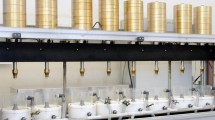Abstract
Recording and transferring of accurate existing occlusal records is of prime importance for a successful restoration. An ideal occlusal registration material should provide minimal resistance to mandibular closure during the registration of maxillomandibular relationships. Interocclusal bite registration materials are partly responsible for accurate precision and occlusal quality of final prosthetic restorations when used for mounting casts on the articulators. The aim of selecting this study is to compare different types of recent interocclusal recording materials and to find the best among them which can resist a constant compressive load and will give the least inaccuracies. In the present study compressive resistance of four interocclusal recording materials viz. Imprint bite, Vitual refill, Jet bite and Ramitec at various thickness (2, 5, 10 and 20 mm) when subjected to a constant compressive load of 25 N was studied. The thickness of the interocclusal recoding materials were selected to simulate various clinical situations. For standardization, the specimens were stored at room temperature for 24 h to simulate the time between clinical and laboratory phases, N = 20 specimens from each group was selected (making a total sample size of N = 80). The SPSS version 17 has been used, two way ANOVA was applied to compare different types of recent interocclusal recording materials, p value ≤0.05 was considered statistically significant. A total of 80 samples were fabricated. Results of two-way analysis of variance (p ≤ 0.05) indicated that there was a significant difference in compressive resistance among the materials of each thickness. The 2 mm thickness specimens showed the least compression and 20 mm thickness specimen showed maximum compression under a constant load of 25 N for all the four materials tested. Virtual Refill bite registration material showed the least compression value than Imprint bite polyvinylsiloxane registration material, Ramitec polyether bite registration material and Jet bite polyvinylsiloxane registration material with negligible error of 0.04 mm found in 2 mm thickness. The results of foregoing study showed that Virtual refill having greater resistance to compression than other interocclusal recording material at various thickness. It exhibit minimal distortion during compression and give clinician the opportunity to make only minimal adjustments to the restorations that were delivered from the laboratory and avoid unnecessary use of chairtime, or repetition of some clinical and technical stages

















Similar content being viewed by others
References
Hatzi P, Tzakis M, Eliades G (2012) Setting characteristics of vinyl: polysiloxanes interocclusal recording materials. Dent Mater 28:783–791
Millstein PL (1985) Accuracy of laminated wax interocclusal wafers. J Prosthet Dent 54:574–577
Breeding LC, Dixon DL (1992) Compression resistance of four interocclusal recording materials. J Prosthet Dent 68:876–878
Dua MP, Gupta SH, Ramachandran S, Sandhu HS (2007) Evaluation of four elastomeric interocclusal recording materials. MJAFI 63:237–240
Tejo SK, Kumar AG, Kattimani VS, Desai PD, Nalla S, Chaitanya K (2012) A comparative evaluation of dimensional stability of three types of interocclusal recording materials-an in vitro multi-centre study. Head Face Med 8:27
Keyf F, Altunsoy S (2001) Compressive strength of interocclusal recording materials. Braz Dent J 12(1):43–46
Biradar S, Gangadhar SA (2011) Comparison of compressive resistance among the elastomeric interocclusal recording materials: in vitro study. JIDA 5(6):710–714
Sharma LA, Azhagarasan NS, Shankar C, Sharma A (2011) Comparitive study of the effect of three different interocclusal recording materials on reproducibility of horizontal condylar registrations in two different semiadjustable articulators: a clinical study. Int J Prosthodont Restor Dent 1:155–162
Tripodakis AP, Vergos VK, Tsoutsos AG (1997) Evaluation of the accuracy of interocclusal records in relation to two recording techniques. J Prosthet Dent 77:141–146
Vergos VK, Tripodakis AD (2003) Evaluation of vertical accuracy of interocclusal records. Int J Prosthodont 16:365–368
Michalakis KX, Pissiotis A, Anastasiadou V, Kapari D (2004) An experimental study on particular physical properties of several interocclusal recording media. Part III: resistance to compression after setting. J Prosthodont 13:233–237
Strohaver RA (1972) Comparison of articulator mountings made with centric relation and myocentric position records. J Prosthet Dent 28:379–390
Michalakis KX, Pissiotis A, Anastasiadou V, Kapari D (2004) An experimental study on particular physical properties of several interocclusal recording media. Part II: linear dimensional change and accompanying weight change. J Prosthodont 13:150–159
Michalakis KX, Pissiotis A, Anastasiadou V, Kapari D (2004) An experimental study on particular physical properties of several interocclusal recording media. Part I: consistency prior to setting. J Prosthodont 13:42–46
Fattore L, Malone WF, Sandrik JL, Mazur B, Hart T (1984) Clinical evaluation of the accuracy of interocclusal recording materials. J Prosthet Dent 51:152–157
Craig RG (1997) Impression materials. In: Craig RG (ed) Restorative dental materials, 10th edn. Mosby-Year Book, St. Louis, p 314
Author information
Authors and Affiliations
Corresponding author
Rights and permissions
About this article
Cite this article
Nagrath, R., Lahori, M., Kumar, V. et al. A Comparative Study to Evaluate the Compression Resistance of Different Interocclusal Recording Materials: An In Vitro Study. J Indian Prosthodont Soc 14 (Suppl 1), 76–85 (2014). https://doi.org/10.1007/s13191-014-0369-8
Received:
Accepted:
Published:
Issue Date:
DOI: https://doi.org/10.1007/s13191-014-0369-8




